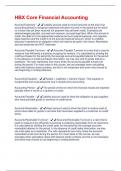Exam (elaborations)
HBX Core Financial Accounting Questions + Answers Graded A+
- Course
- Institution
Accrued Expenses - ️️Liability account used to record amounts at the end of an accounting period to recognize expenses that were incurred in the period but for which no invoice has yet been received nor payment has yet been made. Examples are salaries/wages payable, accrued rent expense, acc...
[Show more]



